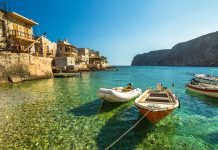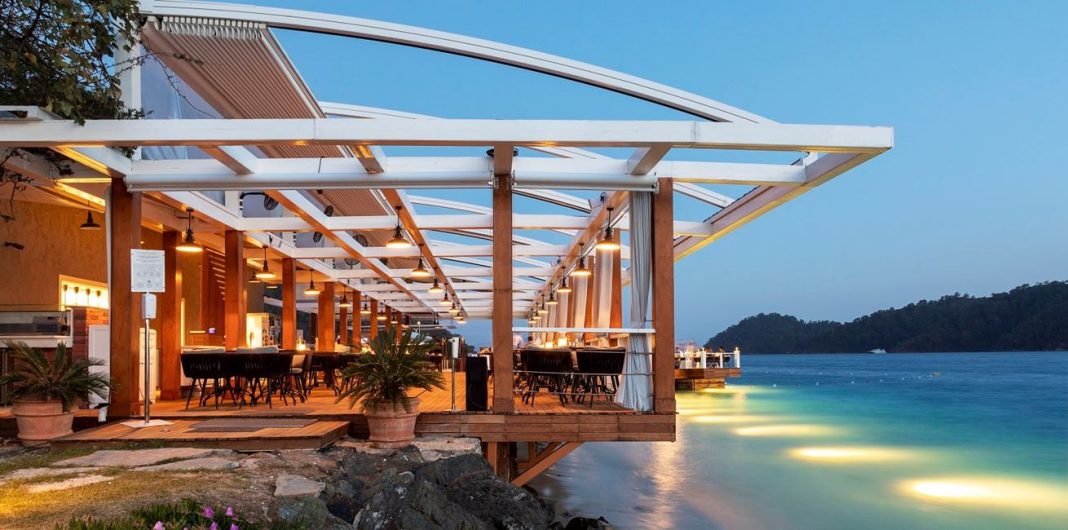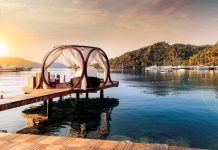Mardin is an extremely attractive place that should not be missed. Minarets soar into the sky from a tightly baked, brownish maze of winding streets, a fortress dominates the old town, and stone houses cascade down the mountainside to the Mesopotamian plains. The melting pot of Kurdish, Yezidi, Christian and Syrian cultures has made this city unusual and diverse.
Do not expect that it will belong only to you. Regular flights from Istanbul bring many tourists here in the summer. The Turkish government also plans to promote Mardin on the international stage on a par with classic tourism centers such as Ephesus and Pamukkale, optimistically expecting an influx of five million domestic and foreign visitors annually in the next 10 years.
A honey-colored collage of old Mardin houses and colorful markets is definitely worthy of attention, and if you want to add something special to your impressions, you can also go to Daru or Savur.
The history of Mardin is a thousand-year-long war between rival armies. However, recently the only conflict that really worries everyone is the opposition of the Kurdistan Workers’ Party to the government of the country. The fortress on this hill has stood since time immemorial. Traditionally, it was occupied by the Turkish army, but while working on the book, we learned that the monument was being transferred to the city and it was planned to open it to the public.
The Assyrians who professed Christianity settled in these parts in the fifth century; from 640 to 1104, Martin was under the rule of the Arabs. After that, the Seljuk Turks, Kurds, Mongols and Persians consistently dominated here, and in 1517 the Ottoman Turks appeared under the leadership of Sultan Selim I the Terrible. During the unrest in the early twentieth century, many Assyrian Christians died or were expelled, and over the past few decades, many of the remaining emigrated. The number of remaining Christians is estimated at 600, with services held consecutively in 11 churches.
Attractions and outdoor activities
Housed in a carefully restored room of former army barracks, the magnificent new museum tells about the fascinating history and culture of Mardin. The high-quality translation of information into English and the effective use of audio and video resources correspond to the level of Mardin’s cosmopolitan and multicultural past. The lower floor serves as an art gallery, where temporary exhibitions are held, and the works of leading Turkish photographers are often exhibited here.
Sultan Isa Madrasah
The attraction of the complex, built in 1385, is an impressive portal sunk into the wall, but be sure to walk through the wonderful courtyards, which are carefully cared for by the caretaker, and climb onto the roof to enjoy the views of the city. The tea Garden is a great place to relax and enjoy the beauty of Mardin.
Market
This hub of trading activity in Mardin stretches parallel to Jumhuriyet Street, one block downhill. The main mode of transport here is still donkeys in charmingly decorated harness. Check out the work of saddlers, who can, it seems, revive completely dilapidated products.
Do not ignore the secluded Ulu Jami mosque, built in the XII century by the Iraqi Seljuks, which was seriously damaged during the Kurdish uprising of 1832. Its interior is very simple, but the exquisite reliefs decorating the minaret make the building worth visiting.
Church of the Forty Martyrs
The church dates from the IV century, in the XV century. it was consecrated anew in honor of the Cappadocian martyrs, who are now recalled by the excellent relief above the entrance. Services are held on Sundays, there is a charming courtyard in which birds often sing. The caretaker is usually on site and opens a small but beautiful interior of the church for visitors.
Mardin Museum
This beautifully restored mansion of the late XIX century stands out with carved columns and elegant arcades on the top floor. Inside there is a small but well-presented collection, including one dating back to the VII century. an Assyrian vase of the finest workmanship and finds made during the excavations of the Bronze Age settlement of Girnavaz, located 4 km north of Nusaybin.
After that, head east along Jumhuriyet Street, paying attention to the magnificent example of the residential architecture of the city to your left – the three-arch facade of the ornately carved old Mardin house.
Post Office
The most impressive former building of the Turkish post office was converted from a 17th-century caravanserai, it is covered with carvings, including on stone gutters and walls. During the work on the book, the building was in a state of thorough restoration, the opening is expected in 2013.
Shehidiye jami
The elegant and slender minaret of this 14th-century mosque stands across the street from the post office. The drum of the mosque is encircled by colonnades, it is covered with stunning carvings, and the top is crowned by three small onion-shaped domes mounted on top of each other. There are several columns at the base of the minaret.
Worthy of a visit and built in the XIV century . Latifiye jami, which is located behind the Akbank bank building. It has a shady courtyard with a shadyrvan in the middle.
In the neighborhood, next to the Artuklu Kervansarayi Hotel, there are the completely restored wonderful mosques of Khatyniye jami and Melik Mahmut Jami.
Kasymiye Madrasah
In 1469, two domes were built over the tombs of Kasim Pasha and his sister, but the grandiose courtyard surrounded by an arched colonnade and decorated with a magnificent carved portal is noteworthy. At the top, before climbing the stairs to the roof, which offers another outstanding panorama of Mardin, you will see the rooms for students. The madrasah is located 800 m south of Yeni Yol. High-quality pointers lead to it.
Surroundings of Mardin
DEIRUL ZAFARAN
The magnificent DeirulZafaran is located about 6 km east of Mardin, among rocky hills; it can be reached by a good but narrow road. Once this monastery was the residence of the patriarchs of the Syrian Orthodox Church, but now the patriarchate has moved to Damascus.
The first monastery on this site was built in 495, on the site of a cult place of sun worshippers, In 607 the monastery was destroyed by the Persians, rebuilt again, and six centuries later it was plundered by the soldiers of Tamerlane.
Shortly after entering the walled space through a portal with inscriptions in Syriac, you will see the original sanctuary – a gloomy underground chamber with a vault of huge, tightly fitted stones. It is believed that the sanctuary belonged to sun worshippers who watched the sunrise of their god through a window in the eastern wall. The niche in the south wall probably served for sacrifices. Next door is a pair of 300-year-old doors to the graves of patriarchs and metropolitans who served here before.
In the chapel, to the left of the altar, there is a patriarchal throne with the names of all the patriarchs who served in the monastery since 792. The patriarchs of the past are buried in sitting positions, facing east, in full vestments, so that they are ready to appear before the Lord in a solemn form.
To the right of the altar stands the Metropolitan throne. A modern stone altar replaced an old wooden one that burned down half a century ago. The walls are decorated with wonderful paintings and wall hangings. The service is conducted in Aramaic.
In the following rooms you will see a font and palanquins intended for carrying church dignitaries.
In a small side room there is a 300-year-old wooden throne. The mosaic on the floor is about 1500 years old.
A flight of stairs leads to very simple guest rooms where pilgrims stay. There is also a small, simple bedchamber and a living room of the patriarch.
There is no public transport to get here, so you can take a taxi or walk from Mardin, it will take about an hour and a half. Near the offices of bus companies in Mardin, drivers will be waiting for you with hope, ready to take you there and back for £40.
Try to pay a visit to the monastery on a weekday, otherwise the silence of this place will be disturbed by buses with Turkish tourists.










